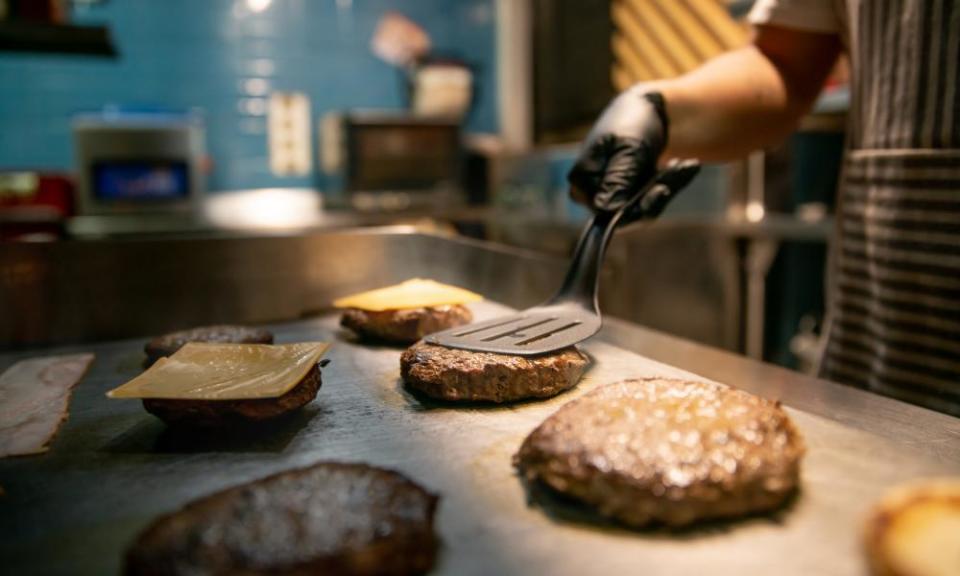Calories on menus ‘may not be helpful’ in drive against obesity

A Big Mac has 508. Wagamama’s hot chicken katsu curry has 1,089. And a large mixed grill with chips at Wetherspoon’s has 2,052. But will knowing how many calories are in a restaurant meal help make a difference to the UK’s obesity epidemic?
From April, all cafes and restaurants run by companies with more than 250 staff will be obliged to include calorie counts for each item on their menus. The government hopes this will encourage people to make healthier choices and nudge restaurants towards offering healthier options.
But many of the UK’s largest chains have told the Observer that they are not changing their menus as a result of the new regulations, and obesity campaigners say that the measure is unlikely to have any impact.
Stuart Flint, an associate professor of the psychology of obesity at Leeds University and a director of Obesity UK, which supports overweight people, said it was unclear who the new rules would help.
“It might not be helpful,” he said. “We need to really understand how people are going to engage with this. Is it going to mean that people only look at calories? A chocolate bar is less than a balanced meal, but we don’t want people to be having a chocolate bar and skipping the meal. It’s not always about reducing the amount we eat.”
Gregg Wallace, the presenter of MasterChef and founder of weight-loss website ShowMe.Fit, is more optimistic that it could make a difference. “Any information or understanding of calorie content in our food – whether in takeaway menus or in restaurants – is a great idea,” he said. “What we can measure, we can manage – and this is another step towards enabling people to make more educated choices.”
The Observer surveyed companies representing more than 20 of the UK’s biggest restaurant and fast-food outlets to see if they were making changes as a result of the new regulations.
All said they were not reformulating their menus to take the rules into account and already offer a range of healthier options. Many already publish calorie counts either on menus or on their websites and most said they had been reformulating their menus to reduce fat, salt and sugar for several years.
McDonald’s said it would adapt its menu to provide specific calorie information for extras, such as cheese slices on burgers, and had already reformulated its products. “Ninety per cent of our core food and drinks menu [is] 500 calories or under in the UK,” a spokesperson said.
KFC’s head of food and quality, Jo Tivers, said the chain had been first in its sector to put calories on menu boards. “This year will mark four years since we committed to removing 20% of calories per serving by 2025.”
Pizza Express, Wagamama and Nando’s said they already published calorie information on their websites and would start printing information on their menus in April. Nando’s said the April deadline was “not a huge milestone for us because we’ve always tried to be transparent about our calorie information”.
Wetherspoon said it had included calorie information on menus since 2012 and was not going to amend them. A spokesman said the pub chain wanted customers to be able to make informed decisions and was “in no way preaching to customers – simply giving them the information that was not available in other pubs”.
However, none of the chains that already put calories on menus said they had measured whether it had any effect on customers’ behaviour.

Calorie labelling in the US came into force in 2018, and a study last year of 59 restaurant chains found that there was no change to the average calorie count on menus. But new dishes introduced after 2018 did have lower calorie content, on average.
Flint said that things like the placement of fast food advertisements, a lack of green space for exercise and stigma attached to obesity were all equally important. Flint compared restaurant labelling to the Soft Drinks Industry Levy (SDIL), introduced in 2018, which taxes the most sugary soft drinks at 24 pence per litre. It was introduced in the hope that customers will buy less and manufacturers will reduce the amount of sugar in the drinks, and a study by Cambridge’s Centre for Diet and Activity Research found that it had led to an average reduction of about 30g of sugar per household per week.
“But who is consuming less sugar?” Flint said. “There’s no data that says that children with obesity, or even people living with obesity are consuming less sugar.
“The reality is that we’ve had 14 policies over the last 20 years related to obesity, and it hasn’t decreased, it’s increased. And the reason is that most of those are focused on individual changing.” Flint said.
“Obesity is very complex. If it was as simple as eating less or more, people wouldn’t gain weight to the extent we have at the moment, and people would be able to lose weight more easily.”
The government estimates that 63% of adults in the UK are at increased risk of serious disease and becoming seriously ill with Covid as a result of being overweight. A Public Health England survey found that nearly 80% of respondents were in favour of calorie labelling, and eating out can account for up to a quarter of adult energy intake, according to a National Centre for Social Research study.
A Department of Health and Social Care spokesperson said: “Obesity is one of the most significant health challenges we face. Clear food labelling plays an important role in helping people make healthier choices for themselves and for their families, and we have consulted extensively with a wide range of experts on these proposals.”

 Yahoo News
Yahoo News 